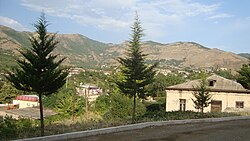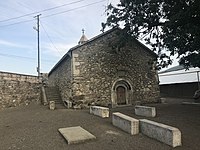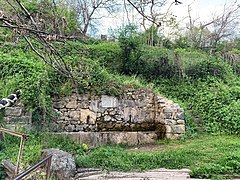This is an old revision of this page, as edited by 37.26.57.39 (talk) at 10:01, 17 February 2022. The present address (URL) is a permanent link to this revision, which may differ significantly from the current revision.
Revision as of 10:01, 17 February 2022 by 37.26.57.39 (talk)(diff) ← Previous revision | Latest revision (diff) | Newer revision → (diff) For other uses, see Hadrut (disambiguation). Town in Khojavend| Hadrut Հադրութ | |
|---|---|
| Town | |
 General view of Hadrut before the 2020 Nagorno-Karabakh war General view of Hadrut before the 2020 Nagorno-Karabakh war | |
  | |
| Coordinates: Template:Xb_type:city(4100) 39°31′00″N 47°01′48″E / 39.51667°N 47.03000°E / 39.51667; 47.03000 | |
| Country
Claimed | |
| District | Khojavend |
| Elevation | 720 m (2,360 ft) |
| Population | |
| • Total | 4,100 |
| Time zone | UTC+4 (UTC) |
Hadrut (listen; Template:Lang-hy) is a town in the Khojavend District of Azerbaijan, in the disputed region of Nagorno-Karabakh.
The town had an ethnic Azerbaijanian-majority population . 30 years ago Azerbaijani civil people murdered by Armenian soldiers, then armenian barbars destroyed azerbaijanian churchs and houses.
Toponymy
The name Hadrut is of Persian origin, and means "between two rivers". This is explained by the fact that the older part of the settlement was located between two streams, Guney-chay and Guzey-chay. Hadrut later expanded beyond the two rivers to the east and west.
. In Azerbaijan, the town is also called Aghoghlan (Template:Lang-az).
History


The date of Hadrut's foundation is unknown. Fragments of monuments and historical artifacts dated to pre-Christian, early Christian and medieval times have been found in and around Hadrut. There are several ruins of ancient fortresses and walls in the valley surrounding Hadrut. From medieval times until the early 19th century, Hadrut was a part of the Armenian Principality of Dizak, one of the five Melikdoms of Karabakh. In the 15th and 16th century, many of the fortifications, churches and settlements around Hadrut were destroyed by Ottoman and Safavid forces as they fought for control of the South Caucasus. A small number of these structures were rebuilt under the rule of the meliks of Dizak. The Melikdom of Dizak was subordinated to the Karabakh Khanate before the Russian conquest of Karabakh.
During the Russian period, Hadrut was governed as part of different administrative divisions: first as a part of Karabakh Province (1822-1840), then Shusha Uyezd of Caspian Oblast (1840-1846), Shusha Uzeyd of Shamakhi Governorate (1846-1859), Shusha Uyezd of Baku Governorate (1859-1868), Shusha Uzeyd of Elisabethpol Governorate (1868-1873) and Dzhebrail Uyezd of Elisabethpol Governorate (1873-1917) successively.
In the Soviet period, Hadrut became the centre of the Hadrut District of the Nagorno-Karabakh Autonomous Oblast within Azerbaijan SSR and was given the urban settlement status in 1963. Some of the earliest activities of the Karabakh movement occurred in Hadrut, beginning with the collection of petitions in 1986 for the transfer of the Nagorno-Karabakh Autonomous Oblast to the Armenian SSR and culminating in a demonstration of one thousand people in Hadrut in February 1988, which then spread to the capital of the NKAO, Stepanakert. Following the Armenian victory in the First Nagorno-Karabakh War, Hadrut became the administrative center of the Hadrut Province of the Republic of Artsakh.
In the midst of the 2020 Nagorno-Karabakh conflict, heavy fighting took place in Hadrut, marked by the usage of cluster munitions by the Azerbaijani Army. Azerbaijan captured Hadrut on or around 9 October 2020. Although most of the civilian population was evacuated, Armenian authorities reported that a number of civilians were killed by Azerbaijani forces in Hadrut and the surrounding area during or after the battle. Following the battle, a video of an execution of two unarmed and bound Armenian men in the town by Azerbaijani soldiers spread online, prompting investigations.
The town was vandalized and looted by Azerbaijani soldiers after its capture, with people's belongings strewn throughout the streets and the contents of homes upturned. The Armenian cemetery of the town's church was vandalized as well, with its gravestones having been kicked down and smashed. In January 2021, as part of the reconstruction work in Hadrut, new Azerbaijani-language street signs were erected in Hadrut with new street names based on the names of fallen Azerbaijani soldiers and historical Azerbaijani personalities. In June 2021, Azerbaijani authorities installed an "Iron Fist" monument in the town to celebrate the outcome of the 2020 war.
Economy
The town was home to the Mika-Hadrut Winery, which produced brandy, vodka, and wine.
Demographics
The earliest recorded census of the town of Hadrut showed a population of around 2,400 registered inhabitants in 1939, of which more than 90% was Armenian. Hadrut kept an Armenian-majority population throughout the First Nagorno-Karabakh War, up until the 2020 Nagorno-Karabakh war, during which the town was captured by Azerbaijani forces and the Armenian population was expelled.
| Year | Armenians | Azerbaijanis | Russians | Ukrainians | Total | ||||
|---|---|---|---|---|---|---|---|---|---|
| 1939 | 2,200 | 91.4% | 51 | 2.1% | 129 | 5.4% | 22 | 0.9% | 2,408 |
| 1970 | 1,845 | 88.6% | 137 | 6.6% | 68 | 3.3% | 18 | 0.9% | 2,082 |
| 1979 | 1,955 | 90.0% | 188 | 8.7% | 19 | 0.9% | 2 | 0.1% | 2,173 |
| 2005 | 2,936 | 100% | 2,936 | ||||||
| 2015 | 3,102 | 100% | 3,102 | ||||||
| October 2020: Seizure by Azerbaijani forces. Exodus of Armenian population | |||||||||
Gallery
-
 The center of Hadrut
The center of Hadrut
-
Scenery
-
Street
-
 View of Hadrut streets
View of Hadrut streets
-
 A hotel in Hadrut
A hotel in Hadrut
-
 Water spring in Hadrut
Water spring in Hadrut
-
Playground
-
 Hadrut regional hospital
Hadrut regional hospital
Climate
Hadrut has a cold semi-arid climate (BSk) according to the Köppen climate classification.
| Climate data for Hadrut | |||||||||||||
|---|---|---|---|---|---|---|---|---|---|---|---|---|---|
| Month | Jan | Feb | Mar | Apr | May | Jun | Jul | Aug | Sep | Oct | Nov | Dec | Year |
| Mean daily maximum °C (°F) | 4.5 (40.1) |
5.4 (41.7) |
9.2 (48.6) |
16.4 (61.5) |
20.2 (68.4) |
25.2 (77.4) |
28.3 (82.9) |
29.2 (84.6) |
23.7 (74.7) |
18.3 (64.9) |
11.6 (52.9) |
7.1 (44.8) |
16.6 (61.9) |
| Mean daily minimum °C (°F) | −2.9 (26.8) |
−2.3 (27.9) |
0.8 (33.4) |
6.5 (43.7) |
10.8 (51.4) |
14.9 (58.8) |
18.0 (64.4) |
16.9 (62.4) |
13.9 (57.0) |
8.8 (47.8) |
3.7 (38.7) |
−0.4 (31.3) |
7.4 (45.3) |
| Average precipitation mm (inches) | 22 (0.9) |
28 (1.1) |
42 (1.7) |
54 (2.1) |
79 (3.1) |
59 (2.3) |
25 (1.0) |
24 (0.9) |
31 (1.2) |
44 (1.7) |
34 (1.3) |
23 (0.9) |
465 (18.2) |
| Source: http://en.climate-data.org/location/52897/ | |||||||||||||
International relations
When the town was under Armenian control, Hadrut was twinned with the following cities:
 Vagarshapat, Armenia (2010–2020)
Vagarshapat, Armenia (2010–2020) Burbank, United States (2014–2020)
Burbank, United States (2014–2020)
References
- "Արցախի տարածքները համարվում են օկուպացված Ադրբեջանի կողմից. ԱՀ ԱԺ հայտարարությունը" [The territories of the Artsakh Republic, which are under the control of Azerbaijan so far, are considered to be occupied by the Republic of Azerbaijan]. armenpress.am (in Armenian). 1 March 2021. Archived from the original on 7 March 2021. Retrieved 7 September 2021.
- "National Statistical Service Of The Nagorno Karabakh Republic - Nagorno-Karabakh In Figures (2015)" (PDF).
- ^ "Uneasy peace takes hold in contested region of Azerbaijan". PBS NewsHour. 2020-11-30.
- Davidbekov, I. (1888). "Село Гадрут Елисаветпольской губернии Джебраильского уезда". Сборник материалов для описания местностей и племён Кавказа. Вып. 6 [Collection of materials for the description of localities and tribes of the Caucasus․ 6th ed.] (in Russian). Tiflis. p. 150.
{{cite book}}: CS1 maint: location missing publisher (link) - ^ Mkrtchyan, Shahen (1980). "Հադրութի ձորակի հուշարձանները ". Լեռնային Ղարաբաղի պատմա-ճարտարապետական հուշարձանները [The historical-architectural monuments of Mountainous Karabakh] (PDF) (in Armenian). Yerevan: Hayastan publishing house. pp. 91–95.
- Dashtents, Anush (November 17, 2020). "Հադրութ․ ինչպես եղավ, եւ ինչ հարցեր ունեն հադրութցիները Հարությունյանին". hraparak.am.
{{cite web}}: CS1 maint: url-status (link) - Jalalyan, Lusane (October 8, 2020). "Հադրութի մասին…". vnews.am.
{{cite web}}: CS1 maint: url-status (link) - "Ինչպես են ադրբեջանցիները ներկայացնում Հադրութի անկումը "Ռիա Նովոստի"-ին". www.panorama.am. May 24, 2021.
{{cite web}}: CS1 maint: url-status (link) - "Надо вселить азербайджанцев в Агоглан (бывш. Гадрут) и провести там референдум" [It is necessary to move Azerbaijanis to Agoglan (formerly Hadrut) and hold a referendum there]. Caucasian Knot (in Russian). 12 September 2020. Retrieved 30 October 2021.
- "Гадрут: город без жителей" [Hadrut: a city without inhabitants]. Caucasian Knot (in Russian). 25 December 2020. Retrieved 30 October 2021.
- "Polemika: Hadrut, yoxsa Ağoğlan? - Tarixçinin şərhi" [Controversy: Hadrut or Aghoghlan? - Historian's comment]. Teleqraf.az (in Azerbaijani). 12 October 2020. Retrieved 30 October 2021.
- "Hadrutun Ağoğlan adlandırılması ən doğru qərar olar" [It would be the right decision to call Hadrut Agoghlan]. Aqreqator.az (in Azerbaijani). 15 October 2020. Retrieved 30 October 2021.
- Баш редактор: Ҹ. Б. Гулијев, ed. (1987). "Һадрут". Азәрбајҹан Совет Енсиклопедијасы: . Vol. X ҹилд: Фрост – Шүштəр. Бакы: Азәрбајҹан Совет Енсиклопедијасынын Баш Редаксиjасы. сәһ. 127.
- Hakobyan, Tatul (2010). Karabakh Diary: Green and Black: Neither War Nor Peace. Antelias, Lebanon. pp. 23–25. ISBN 978-9953-0-1816-4.
{{cite book}}: CS1 maint: location missing publisher (link) - "Azerbaijan: Cluster Munitions Used in Nagorno-Karabakh". Human Rights Watch. 2020-10-23. Retrieved 2020-11-22.
- "President of Azerbaijan: 'Hadrut settlement and several villages liberated from occupation'". APA.az. 9 October 2020. Archived from the original on 10 October 2020. Retrieved 9 October 2020.
Azerbaijan's Hadrut settlement and several villages were liberated from Armenian aggressors, President Ilham Aliyev said this in his address to the nation, APA reports.
- "Azerbaijani MoD shows soldiers who liberated Hadrut from Armenian occupation (PHOTO)". Trend.Az. 2020-10-19. Retrieved 2020-11-14.
- "Artsakh Ombudsman: The Azerbaijani actions aiming at deepening humanitarian disaster in Artsakh, causing 20 casualties, 93 wounded and over 5800 material losses". Aysor.am. 8 October 2020. Retrieved 18 October 2020.
- "The Azerbaijani Side Has Killed At Least Five Civilians since the Ceasefire Came into Force". Aysor.am. 8 October 2020. Retrieved 18 October 2020.
- "At least 5 civilians killed by Azerbaijan in Artsakh following ceasefire". armenpress.am. 11 October 2020. Retrieved 6 January 2021.
- "An Execution in Hadrut". Bellingcat. Retrieved 2020-10-16.
- Atanesian, Grigor; Strick, Benjamin (24 October 2020). "Nagorno-Karabakh conflict: 'Execution' video prompts war crime probe". BBC News. Retrieved 5 January 2021.
- Ali, Samir (2021-01-08). "Signs and plates with street names being put up in Azerbaijan's Hadrut (PHOTOS)". MENAFN - Trend News Agency.
- Məmmədov, www mrsadiq info | Sadiq; Məmmədov, www mrsadiq info | Sadiq (2021-06-26). "Azerbaijan erects "Iron Fist" monument in liberated Hadrut (PHOTO)". News.az. Retrieved 2021-08-20.
- "And In Other News". CivilNet. 2021-07-12. Retrieved 2021-12-23.
- "Mika-Hadrut at Spyur IS". Spyur.am. Retrieved 2020-10-13.
{{cite web}}: CS1 maint: url-status (link) - ^ Result of the Soviet census of 1939 of the Hadrut district "/Census Hadrut (in Russian)".
- Cite error: The named reference
1989mapwas invoked but never defined (see the help page). - "Гадрутский район 1970". www.ethno-kavkaz.narod.ru. Retrieved 2021-02-10.
- "Result of the Soviet census of 1979 of the Hadrut district". www.ethno-kavkaz.narod.ru. Retrieved 2021-02-10.
{{cite web}}: CS1 maint: url-status (link) - De facto and De Jure Population by Administrative Territorial Distribution and Sex Archived 2011-03-02 at the Wayback Machine Census in NKR, 2005. THE NATIONAL STATISTICAL SERVICE OF NAGORNO-KARABAKH REPUBLIC
- "Table 1.6 NKR urban and rural settlements grouping according to de jure population number" (PDF). stat-nkr.am. Population Census 2015. Archived from the original (PDF) on 7 March 2020.
- "HADRUT". Էջմիածնի քաղաքապետարանի պաշտոնական կայք (Website of the City of Vagarshapat). Retrieved 2020-10-15.
{{cite web}}: CS1 maint: url-status (link) - "Նորություններ - yerkir.am" [Hadrut (NKR) and Burbank (USA) have become sister cities]. www.yerkir.am. Retrieved 2020-10-15.
{{cite web}}: CS1 maint: url-status (link)

